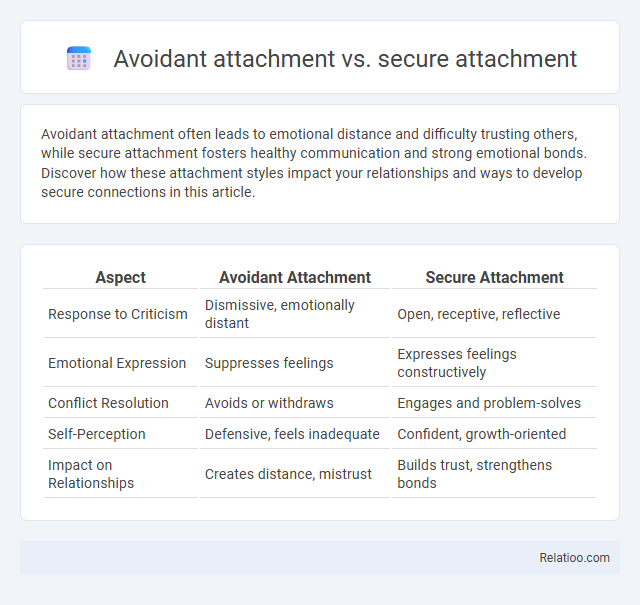Avoidant attachment often leads to emotional distance and difficulty trusting others, while secure attachment fosters healthy communication and strong emotional bonds. Discover how these attachment styles impact your relationships and ways to develop secure connections in this article.
Table of Comparison
| Aspect | Avoidant Attachment | Secure Attachment |
|---|---|---|
| Response to Criticism | Dismissive, emotionally distant | Open, receptive, reflective |
| Emotional Expression | Suppresses feelings | Expresses feelings constructively |
| Conflict Resolution | Avoids or withdraws | Engages and problem-solves |
| Self-Perception | Defensive, feels inadequate | Confident, growth-oriented |
| Impact on Relationships | Creates distance, mistrust | Builds trust, strengthens bonds |
Understanding Attachment Styles
Understanding attachment styles reveals key differences between avoidant attachment and secure attachment, with avoidant individuals often exhibiting emotional distance and reluctance to rely on others, while secure attachment is characterized by comfort with intimacy and trust in relationships. You can improve your interpersonal connections by recognizing these patterns and addressing avoidant tendencies that hinder closeness. Research indicates that secure attachment fosters healthier communication and emotional regulation compared to the defensive strategies typical of avoidant attachment.
What Is Avoidant Attachment?
Avoidant attachment is characterized by a discomfort with closeness and dependency, leading individuals to maintain emotional distance and suppress their feelings to avoid vulnerability. Unlike secure attachment, which fosters healthy intimacy and trust, avoidant attachment results from early experiences of rejection or emotional unavailability, causing difficulties in forming deep, trusting relationships. Understanding your attachment style can help you recognize patterns in your relationships and work towards building stronger emotional connections.
Characteristics of Avoidant Attachment
Avoidant attachment is characterized by a strong desire for independence, emotional distance, and difficulty trusting others, often leading to reluctance in forming close relationships. Unlike secure attachment, which features comfort with intimacy and balanced dependence, avoidant individuals tend to suppress their emotions and avoid vulnerability. Recognizing these traits can help you understand relationship dynamics and foster healthier connections.
What Is Secure Attachment?
Secure attachment is characterized by comfort with intimacy and trust in relationships, allowing individuals to seek support and express emotions openly. Unlike avoidant attachment, which involves emotional distance and self-reliance to avoid vulnerability, secure attachment promotes healthy communication and resilience in stress. Research in psychology highlights secure attachment as foundational for stable, fulfilling interpersonal connections and emotional wellbeing.
Characteristics of Secure Attachment
Secure attachment is characterized by trust, effective communication, and emotional availability, allowing individuals to form healthy, stable relationships. Your ability to seek comfort and offer support during times of stress reflects the core traits of secure attachment. This style fosters self-confidence and resilience, promoting balanced interdependence and emotional regulation.
Key Differences: Avoidant vs Secure Attachment
Avoidant attachment is characterized by emotional distance and difficulty trusting others, while secure attachment involves comfort with intimacy and balanced dependence. Your relationships may suffer under avoidant attachment due to reluctance to seek support, whereas secure attachment fosters open communication and emotional responsiveness. Understanding these key differences helps promote healthier, more fulfilling connections.
Impact on Adult Relationships
Avoidant attachment often leads to difficulties in expressing emotions and maintaining intimacy, causing challenges in forming close adult relationships. Secure attachment fosters healthy communication, trust, and emotional availability, which support stable and fulfilling partnerships. Understanding your attachment style can improve relationship dynamics and promote emotional resilience.
Signs You Have an Avoidant or Secure Attachment
Individuals with avoidant attachment often exhibit signs such as discomfort with intimacy, difficulty trusting others, and a tendency to maintain emotional distance. Those with secure attachment demonstrate healthy communication, ease in forming close relationships, and emotional resilience. Recognizing these patterns helps differentiate avoidant attachment's guarded behavior from the openness and trust characteristic of secure attachment.
How to Foster Secure Attachment
To foster secure attachment, you must consistently respond to your child's emotional needs with warmth and sensitivity, creating a safe environment where trust can flourish. Establishing reliable routines and showing empathy encourages emotional regulation and healthy social development, counteracting the fears associated with avoidant attachment. Prioritizing open communication and emotional availability reinforces your child's sense of security and strengthens the parent-child bond.
Overcoming Avoidant Attachment Patterns
Overcoming avoidant attachment patterns involves building trust and emotional intimacy through consistent, supportive relationships that challenge fear of dependence and vulnerability. Techniques such as mindfulness, therapy, and gradual exposure to closeness help individuals shift from avoidant attachment, characterized by emotional distance and self-reliance, to secure attachment, which fosters healthy communication and emotional regulation. Developing secure attachment promotes resilience and deeper connection, essential for long-term relational satisfaction and psychological well-being.

Infographic: Avoidant attachment vs Secure attachment
 relatioo.com
relatioo.com